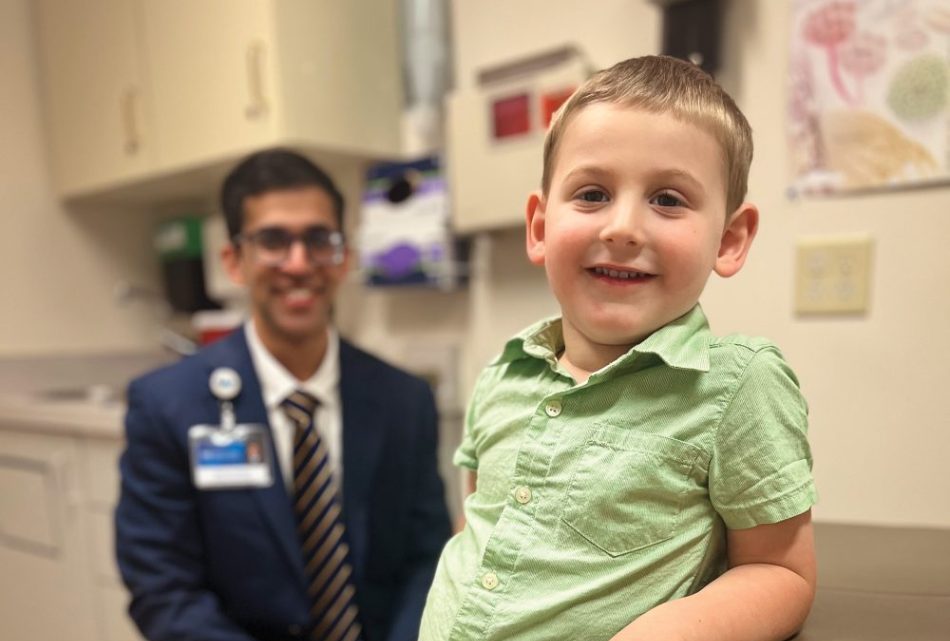
At about three months old, Grayson Sibley began developing severe skin rashes. His parents, Tasha and Alan, talked to Grayson’s primary care physician, who diagnosed him with eczema. He noted children with severe eczema are more likely to have food allergies and referred Grayson to Mayo Clinic in Rochester for testing, the results of which revealed Grayson was allergic to both peanuts and milk.
Tasha and Alan were now faced with a complete lifestyle change—navigating raising a child with food allergies, including diligently reading food labels and learning how to use an emergency EpiPen.
“It was a terrifying feeling as a mom, knowing your baby could suffer severe allergic reactions at any time to such common foods,” says Tasha.
The Sibley family continued Grayson’s care with the allergy team at Rochester’s Mayo Clinic, a 70-mile drive, until 2023, when Dr. Michael D’Netto, a Mayo-Clinic trained allergist, joined the Mayo Clinic Health System practice at WinnMed.
“When I learned Dr. D’Netto would be in Decorah, I immediately planned to transfer Gray’s care to WinnMed. We had a great experience in Rochester, and Dr. D’Netto was trained by the very physicians who were part of Gray’s care team.”
For his next appointment, Grayson was seen at WinnMed. Tasha says, “Dr. D’Netto ordered the same tests Gray was getting in Rochester; it was nice to feel this type of continuity in his care. We were immediately put at ease.”
His three-year old skin and blood tests revealed his allergy to milk was still positive, but peanuts were now negative. Dr. D’Netto says, “It is possible for children to outgrow food allergies. This occurs in over 50 percent of patients with a milk allergy. Therefore, while Grayson still shows evidence of allergic antibodies to milk at this time, he may still outgrow this allergy. Regarding peanut allergy, roughly 20 percent of patients allergic to peanut will outgrow the peanut allergy. Grayson’s negative peanut testing suggested he may be in the fortunate 20 percent of peanut allergic patients. However, consuming peanut itself is the best way to determine a patient’s food allergy status.

Tasha made a follow-up food challenge appointment for Grayson, where he was introduced to progressively larger amounts peanut butter in a clinic setting, carefully monitored by Dr. D’Netto and his nurses. “I wasn’t sure how the morning would go,” says Tasha, “because he was three and he may or may not have cooperated. But, they had toys for him and made the morning fun, so Gray had a great time.”
The results of the food test were exactly what the Sibley family hoped for: Grayson had outgrown his peanut allergy. Tasha says, “The next morning – a Saturday – Gray had his very first PB & J sandwich. It felt like such a milestone for him and our family. It is now his most favorite food!”
Grayson will continue his care with Dr. D’Netto in Decorah, and the family hopes his allergy to milk will follow the same path. Tasha says, “We look forward to the possibility that Grayson might someday be allergy-free, and we are thankful to be able to receive his care locally.
According to the Centers for Disease Control and Prevention (CDC), approximately 10% of all US patients report having an allergic reaction to a penicillin class antibiotic in their past. * Michael D’Netto, M.D., Mayo Clinic Health System allergist at WinnMed in Decorah, says that just 10% of these patients with a reported penicillin allergy are a true allergy. “Thousands of patients at WinnMed alone have a documented allergy to penicillin because of how they reacted to the medication at one point in their past. We know that 10 years after a patient’s reaction to penicillin roughly 80% of patients outgrow their penicillin allergy. Additionally, some reactions are likely misattributed to penicillin, as we know infections themselves are a common cause of hives. As such, many penicillin ‘allergic’ patients could be ‘cleared’ of this allergy, which would allow them to be prescribed penicillin, amoxicillin, and other antibiotics in this class to fight bacterial infections.”
This matters because bacteria can develop a resistance to antibiotics, so having more antibiotic choices as a patient increases the chance of recovery from a bacterial infection. Additionally, some antibiotics are more expensive, so having a penicillin class antibiotic as an option can help patients financially.
Dr. D’Netto offers penicillin allergy testing at WinnMed in Decorah. For an appointment, call 563-382-2911.
*https://www.cdc.gov/antibiotic-use/community/pdfs/penicillin-factsheet.pdf